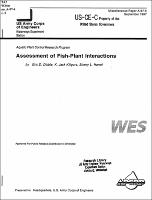Please use this identifier to cite or link to this item:
https://hdl.handle.net/11681/6239| Title: | Assessment of fish-plant interactions |
| Authors: | Dibble, Eric D. (Eric David), 1955- Killgore, K. Jack Harrel, Sherry Lynn, 1970- |
| Keywords: | Aquatic plants Aquatic ecosystems Growth Sampling Ecology Fish Management Foraging Reproduction Aquatic Plant Control Research Program (U.S.) |
| Publisher: | U.S. Army Engineer Waterways Experiment Station |
| Series/Report no.: | Miscellaneous Paper (Aquatic Plant Control Research Program (U.S.)) ; no.Miscellaneous Paper A-97-6 |
| Abstract: | The published literature was reviewed to investigate (A.) the functional importance of aquatic plants to fish, (B.) how aquatic plant and fish populations are measured in vegetated habitats, (C.) the spatial scale at which previous investigators have quantified fish-plant interactions, and (D.) how proximate fish behaviors influence population structure at a macrolevel. Based on results of comparative studies, the typical conclusion bas been that intermediate levels of plants promote high species richness and are optimal for growth and survival of fishes. Predictable responses by fishes to aquatic plants were noted: vegetated habitats supported higher fish densities than unvegetated areas; aquatic plants led to reduced risk of predation; and structurally oriented fish exploited aquatic plant beds. Pelagic species and benthic omnivores often declined in abundance with increased plant cover, and phytophilic fishes showed rapid population increases during plant growing seasons. When plants occupied an entire water body, fish growth became stunted due to depletion of food resources. These interactions have been assessed largely at a macroscale where aquatic plants are generally mapped from aerial photography or surface measurements and fish data are averaged as standing crop, density, catch-effort, or percent abundance relative to plant coverage. Because direct observation of fish in dense plant beds is difficult, few attempts have been made to define and quantify structural complexity of plants at a scale perceived by fishes. Aquatic plant attributes potentially important to growth and survival of fishes are provided, and these authors suggest that microscale assessment of fish behaviors can be linked to macroscale fishery management strategies through analysis of aerial distribution of aquatic plants. |
| Description: | Miscellaneous Paper |
| Gov't Doc #: | Miscellaneous Paper A-97-6 |
| Rights: | Approved for public release; distribution is unlimited |
| URI: | http://hdl.handle.net/11681/6239 |
| Appears in Collections: | Miscellaneous Paper |
Files in This Item:
| File | Description | Size | Format | |
|---|---|---|---|---|
| MP-A-97-6.pdf | Miscellaneous Paper A-97-6 | 1.83 MB | Adobe PDF |  View/Open |